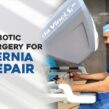The first one is called a congenital hernia. This is usually seen in children or newborn babies, where there is absolutely no defect in the muscle. There is a natural window in the groyne that is usually open for the testicles to pass out; usually they close after birth. If they fail to close, the hole will remain open, and the intestines will start protruding out. This is called a congenital hernia. In these hernias, all that we need to do is put back the intestine that has come back and close the hole with a stitch. Because there is no weakness of muscle involved, you do not need a mesh to repair these hernias.
Traumatic hernia: If somebody gets an injury, especially a stab injury in the abdomen, it can pierce through the abdominal wall, which can cause a hole through which the intestine can come out. This is usually an emergency situation, and in these conditions, there is absolutely no weakness of the muscle wall. It is basically an injury, trauma, or cut that has caused the muscle to give way, and in these conditions, the intestine is just put back and the hernia is repaired using stitches alone in most cases.
Belly button hernias: The belly button is a region that usually does not have muscle. It is a natural weak spot that is a point through which the umbilical cord enters the body, and after the baby is born, it is usually sealed with scar tissue or fibrous tissue. In some people, this scar tissue or thin plunging tissue can become weak and give rise to a small defect through which the intestines can bulge out. This is called an umbilical hernia. If the person has a good tummy tone and abdominal wall muscle tone, and if the belly button hernia is very small, it can easily be repaired with stitches alone without the use of a mesh. There are times when we have very young people with good muscle tone who have groyne hernias repaired without mesh. But these are scenarios that are quite less common than the usual hernia scenarios we see. For the majority of patients, we would require a mesh, but not all hernias require a mesh. These are the scenarios where we do not need to use a mesh to repair a hernia, and a simple repair of the muscle with sutures alone would suffice.



